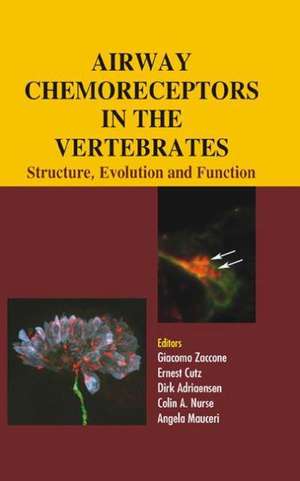Airway Chemoreceptors in Vertebrates
Editat de Giacomo Zacconeen Limba Engleză Hardback – 9 ian 2009
The chemoreceptor cells are sensors which detect the signal changes in the external and internal environments, and play a key role in the survival of various species. Studies addressed to the chemoreceptor cell systems in the airways are of great importance for investigating their response to changes in the oxygen and carbon dioxide concentrations in the environment since the future of the planet earth is being threatened by global warming and climate change.
Praise for the book:
…This volume would be of special interest to researchers who are curious about the evolution of vertebrate respiratory control in general and the regulation of ventilation in nonmammalian vertebrates in particular. —Wayne L. Silver, Wake Forest University, in The Quarterly Review of Biology, Volume 85, Number 2
Preț: 718.76 lei
Preț vechi: 958.02 lei
-25% Nou
Puncte Express: 1078
Preț estimativ în valută:
137.66€ • 141.83$ • 115.31£
137.66€ • 141.83$ • 115.31£
Comandă specială
Livrare economică 03-17 februarie
Doresc să fiu notificat când acest titlu va fi disponibil:
Se trimite...
Preluare comenzi: 021 569.72.76
Specificații
ISBN-13: 9781578086146
ISBN-10: 1578086140
Pagini: 464
Dimensiuni: 152 x 229 x 25 mm
Greutate: 1.02 kg
Ediția:1
Editura: CRC Press
Colecția CRC Press
ISBN-10: 1578086140
Pagini: 464
Dimensiuni: 152 x 229 x 25 mm
Greutate: 1.02 kg
Ediția:1
Editura: CRC Press
Colecția CRC Press
Cuprins
NEUROSECRETORY EPITHELIAL CELLS (NECS) IN THE AIRWAYS AND CAROTID LABYRINTH OF AQUATIC VERTEBRATES: MORPHOLOGY, DISTRIBUTION, INNERVATION AND FUNCTION: Oxygen-sensitive Neuroepithelial Cells in the Gills of Aquatic Vertebrates; Carotid Labyrinth and Associated Pseudobranchial Neurosecretory Cells in Indian Catfishes; Serotonergic Neuroepithelial Cells in Fish Gills: Cytology and Innervation. NEUROSECRETORY CELLS (NECS) IN THE LUNG OF AMPHIBIANS AND ACCESSORY RESPIRATORY ORGANS OF THE AIR-BREATHING FISHES AND IN AMPHIBIAN CAROTID LABYRINTH: STRUCTURAL MORPHOLOGY AND FUNCTION: Neuroendocrine Cells in the Lungs of Amphibians and Air-breathing Fishes; The Amphibian Carotid Labyrinth; Neuroendocrine System of the Amphibian Extrapulmonary Airways; Chemoreceptive Control of Ventilation in Amphibians and Air-Breathing Fishes. NEUROEPITHELIAL BODIES (NEBS) IN THE LUNG OF REPTILES: STRUCTURAL MORPHOLOGY, IMMUNOHISTOCHEMISTRY AND FUNCTION: Neuroendocrine System of the Reptilian Respiratory Tract; Airway Receptors in Birds; Mechanisms of CO2 Sensing in Avian Intrapulmonary Chemoreceptors. PULMONARY NEUROEPITHELIAL CELLS IN MAMMALS: STRUCTURE, MOLECULAR MARKERS, ONTOGENY AND FUNCTIONS: Diverse and Complex Airway Receptors in Rodent Lungs; Oxygen Sensing in Mammalian Pulmonary Neuroepithelial Bodies; Precursors and Stem Cells of the Pulmonary Neuroendocrine Cell System in the Developing Mammalian Lung; Pulmonary Neuroepithelial Bodies as Hypothetical Immunomodulators: Some New Findings and a Review of the Literature; Neuroepithelial Bodies and Carotid Bodies: A Comparative Discussion of Pulmonary and Arterial Chemoreceptors. SOLITARY CHEMOSENSORY CELLS IN THE AIRWAYS OF MAMMALS: DISTRIBUTION, IMMUNOCYTOCHEMISTRY, FINE STRUCTURE AND FUNCTION: Solitary Chemosensory Cells in the Airways of Mammals; Solitary Chemosensory Cells: Phylogeny and Ontogeny; Functional Importance of Pulmonary Neuroendocrine Cells; CO2/H+ Chemoreceptors in the Respiratory Passages of Vertebrates.
Recenzii
This book provides a review of the chemoreceptive cells associated with vertebrate respiration. … Most of the cells described in this volume detect respiratory gases and function to help regulate ventilation. Other roles include immune system activation, defense against bacteria, and environmental chemical detection. The majority of the book looks at the anatomy of respiratory-related structures: lungs (gills), carotid labyrinths (carotid body), and respiratory passages. … There are five sections organized by vertebrate class (fish, amphibians, reptiles/birds, and two for mammals). …This volume would be of special interest to researchers who are curious about the evolution of vertebrate respiratory control in general and the regulation of ventilation in nonmammalian vertebrates in particular.
—Wayne L. Silver, Wake Forest University, in The Quarterly Review of Biology, Volume 85, Number 2
—Wayne L. Silver, Wake Forest University, in The Quarterly Review of Biology, Volume 85, Number 2
Descriere
Considered oxygen receptor neuroepithelial cells, airway chemoreceptors play a key role in the survival of various species: having neuroendocrine functions that detect signal changes in external and internal environments and carrying their signals to the central nervous system. Reflecting recent research into the cellular and molecular biology of chemoreceptors, this book provides a comprehensive, up-to-date account of the morphological, physiological and evolutionary aspects of specialized cells distributed within the epithelia of airways in vertebrates. It highlights studies into chemoreceptor response to changes in oxygen and carbon dioxide concentrations in the environment.
